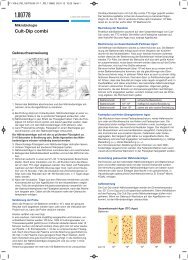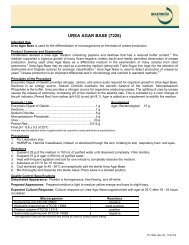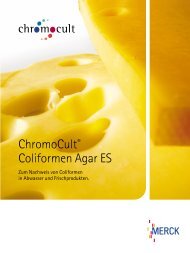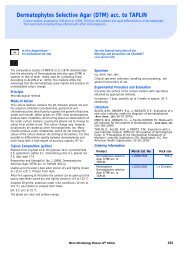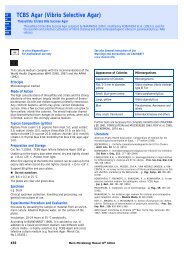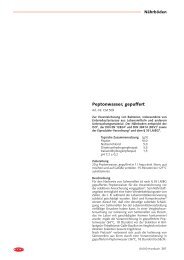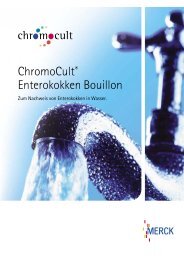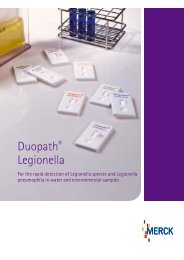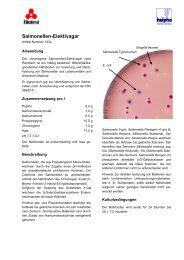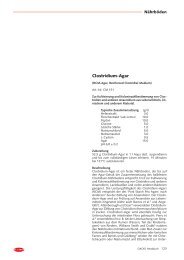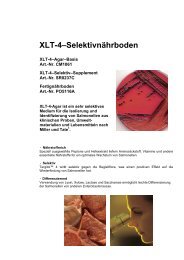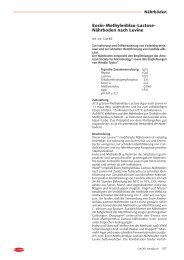Singlepath® Salmonella - mibius
Singlepath® Salmonella - mibius
Singlepath® Salmonella - mibius
Create successful ePaper yourself
Turn your PDF publications into a flip-book with our unique Google optimized e-Paper software.
Singlepath® <strong>Salmonella</strong><br />
GLISA-Rapid Test (Gold Labelled ImmunoSorbent Assay) for the presumptive qualitative detection of <strong>Salmonella</strong> spp<br />
in food.<br />
Singlepath® <strong>Salmonella</strong><br />
Intended Purpose<br />
Singlepath® <strong>Salmonella</strong> GLISA test is an immunochromatographic<br />
rapid test intended for use in microbiology laboratories<br />
analyzing food and animal feeds for the presumptive qualitative<br />
detection of <strong>Salmonella</strong> spp. from food matrices such as meats<br />
(raw ground beef and raw ground turkey), spices (black pepper),<br />
dairy (dried skimmed milk), dried foods (coconut) and seafood<br />
(cooked, peeled frozen prawns).<br />
Introduction<br />
<strong>Salmonella</strong> is one of the most common causes of food poisoning<br />
world-wide. <strong>Salmonella</strong> have been isolated from most types of<br />
raw food (meats, eggs, as well as plant products), and their high<br />
resistance to drying combined with a very high heat resistance<br />
once dried, makes <strong>Salmonella</strong> a potential problem in most foods<br />
and particular in dried products.<br />
Screening for the presence of <strong>Salmonella</strong> in foods by conventional<br />
methods involve a 3-step technique: non-selective preenrichment<br />
(18- 24h), selective enrichment in (at least) two<br />
different selective broth media (24- 48h) followed by plating on<br />
(at least) two different selective/indicative agars (24 - 48h).This<br />
leads to a total time for Yes/No screening result of up to 5 days.<br />
For products where a positive release system is enforced, this<br />
means a delay of 5 days before release of the product.<br />
The Singlepath® <strong>Salmonella</strong> test is an immunological screening<br />
test performed from only one selective enrichment culture, and<br />
gives a Yes/No answer in 20 minutes, meaning that products can<br />
be released 2 days earlier than by conventional microbiology.<br />
Mode of Action<br />
Singlepath® <strong>Salmonella</strong> is an immunochromatographic rapid test<br />
based on gold-labelled antibodies. The test device has a circular<br />
sample port, and an oval shaped test (T) and control (C) window.<br />
1. The sample is applied to the chromatography paper via the<br />
circular sample port.<br />
2. The sample is absorbed through the pad to the reaction zone<br />
containing colloidal, gold-labelled antibodies specific to<br />
<strong>Salmonella</strong> spp.<br />
3. Any <strong>Salmonella</strong> antigen present complexes with the goldlabelled<br />
antibody and migrates through the port until it<br />
encounters a binding zone in the test (T) area.<br />
4. The binding zone (T) contains another anti-<strong>Salmonella</strong> antibody,<br />
which immobilises any <strong>Salmonella</strong>-antibody complex<br />
present. Due to the gold-labelling, a distinct red line is then<br />
formed.<br />
5. The rest of the sample continues to migrate to a second<br />
binding reagent zone within the control (C) zone, and also<br />
forms a second distinct red line (positive control). Regardless<br />
of whether any <strong>Salmonella</strong> is present or not, this distinct red<br />
line is always formed in the control (C) zone, thus ensuring<br />
the test is working correctly.<br />
Storage / Stability<br />
Singlepath® <strong>Salmonella</strong> is stable until the expiry date printed on<br />
the box, when stored at +2 to +8°C.<br />
Sample Material / Sample Enrichment<br />
• Mix 25 g solid sample or 25 ml liquid sample with 225 ml<br />
pre-enrichment broth (BPW) and homogenise for approximately<br />
2 minutes in stomacher if necessary.<br />
• Incubate for 18 ± 2 h at 37°C.<br />
• Inoculate 10 ml RVS selective enrichment broth with 0.1 ml<br />
of pre-enrichment culture.<br />
Incubate for 24 ± 3 h at 41.5°C. Test procedure.<br />
Experimental Procedure and Evaluation<br />
Sample Preparation<br />
1. Transfer approx. 1 - 2 ml of selective enrichment culture to<br />
an appropriate (polypropylene) tube.<br />
2. Place tubes in boiling water bath for 15 min.<br />
3. Remove and allow cooling to room temperature (18 - 26 °C),<br />
prior to use.<br />
Allow test devices to warm to room temperature if stored at +2<br />
to +8°C.<br />
Procedure<br />
1. Remove the foil pouches from the required number of<br />
Singlepath® <strong>Salmonella</strong> devices. Place the test device(s) on a<br />
flat surface and label with appropriate sample identification.<br />
2. Using a micropipette and disposable pipette tip, dispense<br />
160 µl into the circular sample port on the test device.<br />
3. Observe the test result 20 minutes after applying the sample<br />
to the device.<br />
Note: It is recommended to read results no later than 25 minutes<br />
after sample application, before the device starts to dry.<br />
Interpretation of Results<br />
The test can be regarded as working correctly if a distinct red line<br />
appears in the control zone (C) within 20 minutes.<br />
A sample can be considered POSITIVE if at or prior to<br />
20minutes, red lines appear on both test (T) and control (C)<br />
zones.<br />
A sample can be considered NEGATIVE if no red line appears in<br />
the test (T) zone but does appear distinctly in the control (C) zone<br />
20 minutes after application of sample to the device.<br />
As with all rapid immunoassays, this method is presumptive. All<br />
positive results should be confirmed by plating the selective<br />
enrichments to the selective agars indicated in the ISO<br />
6579:2002 or equivalent analysis methods such as USDA-FSIS<br />
MLG 4.02 method, and by analyzing typical isolated colonies<br />
using the biochemical and serological confirmatory techniques<br />
also recommended in this method.<br />
620 Merck Microbiology Manual 12 th Edition
Singlepath® <strong>Salmonella</strong><br />
Technical Specifications<br />
Detection limit<br />
Depending on serogroup, less than 1 colony forming unit in a<br />
25g food sample can be regarded as being the detection limit.<br />
Interferences<br />
Results obtained to date on food samples, such as dried skimmed<br />
milk powder, black pepper, dried pet food (dog food), desiccated<br />
coconut and cooked peeled frozen prawns, indicate that there is<br />
no interference of Singlepath® <strong>Salmonella</strong> with these food<br />
ingredients.<br />
The test has been developed based on using Merck media.<br />
Interference from components of other brands of media cannot<br />
be excluded.<br />
Limitations of the Procedure<br />
• The strength of signal is dependent on serogroup and the<br />
concentration of <strong>Salmonella</strong> cells.<br />
• A positive or negative result does not preclude the presence<br />
of other infectious organisms.<br />
Trouble-shooting<br />
Problem<br />
No line appears in either zone<br />
after 20 minutes test period<br />
Delay in sample reaching<br />
Nitrocellulose membrane<br />
Blue-green colour appearing on<br />
membrane<br />
Measures<br />
Re-run sample<br />
Touch sample pad with pipette<br />
tip<br />
In the rare event that dye from<br />
RVS medium reaches the test<br />
zone within 20 minutes, the<br />
colour does not interfere with<br />
the test signal<br />
Disposal<br />
Decontaminate Singlepath® devices, enrichments, tubes and<br />
pipettes by autoclave, bleach etc in accordance with local, state,<br />
and federal regulations.<br />
Technical Assistance<br />
For technical assistance, please contact your local Merck<br />
representative or Merck KGaA 64271 Darmstadt, Germany.<br />
Tel : +49-6151-720, Fax : +49-6151-72 20 00,<br />
Email: service@merck.de.<br />
Ordering Information<br />
Product Merck Cat. No. Pack size<br />
Singlepath® <strong>Salmonella</strong> 1.04140.0001 25 tests<br />
Peptone Water (Buffered) 1.07228.0500 500 g<br />
<strong>Salmonella</strong> Enrichment<br />
Broth acc. to Rappaport-<br />
Vassiliadis (RVS broth)<br />
Additionally required materials and instrumentation<br />
• Stomacher / Stomacher bags<br />
• Incubators +37 °C and +41.5°C<br />
• Distilled or deionized water<br />
• Autoclave<br />
• Waterbath for boiling of samples<br />
1.07700.0500 500 g<br />
• Disposable heat-stable Polypropylene tubes for boiling of<br />
samples<br />
• Disposable plastic transfer pipettes and/or appropriate micro<br />
pipettes and disposable tips for dispensing 1 - 2 ml (sample<br />
for boiling) and 160 µl (application of boiled sample onto<br />
tests)<br />
Precautions<br />
Users of Singlepath® <strong>Salmonella</strong> must be familiar with the<br />
appropriate aseptic techniques for the isolation and identification<br />
of <strong>Salmonella</strong> spp. Care must be taken when handling<br />
samples, enrichments and devices.<br />
Singlepath® <strong>Salmonella</strong><br />
Test result negative<br />
Singlepath® <strong>Salmonella</strong><br />
Test result positive<br />
Merck Microbiology Manual 12 th Edition 621
Singlepath® <strong>Salmonella</strong><br />
Singlepath® <strong>Salmonella</strong><br />
Strains that were tested and detected positive:<br />
Salm. paratyphi A<br />
ATCC 9150<br />
Salm. kentucky<br />
ATCC 9263<br />
Salm. unnamed ssp.II<br />
Serotype: 11;-;1,5<br />
Salm. karamoja<br />
Salm. derby<br />
ATCC 6960<br />
Salm. gallinarum<br />
ATCC 9184<br />
Salm. friedenau<br />
Salm. sheffield<br />
Salm. abortus-equi<br />
ATCC 9842<br />
Salm. pullorum<br />
ATCC 19945<br />
Salm. luanshya ssp.II<br />
Salm. wandsworth<br />
Salm. typhimurium<br />
ATCC 6994<br />
Salm. panama<br />
ATCC 7378<br />
Salm. warragul<br />
Salm. waycross<br />
Salm. paratyphi B<br />
ATCC 8759<br />
Salm. dublin<br />
ATCC 15480<br />
Salm. zwickau<br />
ATCC 15805<br />
Salm. unnamed ssp. III<br />
Serotype :42;z41,z24;<br />
Salm. typhimurium<br />
ATCC 14028<br />
Salm. enteritidis<br />
ATCC 13076<br />
Salm. kirkee<br />
ATCC 8822<br />
Salm. irigney<br />
Salm. bredeney<br />
ATCC 10728<br />
Salm. javiana<br />
ATCC 10721<br />
Salm. fluntern<br />
Salm. lohbruegge<br />
Salm. chester<br />
ATCC 11997<br />
Salm. maarssen<br />
ATCC 15793<br />
Salm. infantis<br />
ATCC 51741<br />
Salm. deversoir<br />
Salm. infantis<br />
ATCC 51741<br />
Salm. anatum<br />
ATCC 9270<br />
Salm. london ATCC 9389<br />
Salm. quinhon<br />
Salm. bareilly<br />
ATCC 9115<br />
Salm. matroosfontein Salm. eschersheim Salm. ngozi ssp. II<br />
Salm. choleraesuis<br />
ATCC 12011<br />
Salm. vejle<br />
Salm. schalkwijk<br />
ATCC 15785<br />
Salm. bonaire ssp. IV<br />
Salm. choleraesuis<br />
ATCC 13312<br />
Salm. butantan<br />
Salm. minnesota<br />
ATCC 9700<br />
Salm. arizonae<br />
NCTC 8297<br />
Salm. newport<br />
ATCC 6962<br />
Salm. illinois ATCC 11646<br />
Salm. pomona<br />
ATCC 10729<br />
Salm. uccle<br />
Salm. breukelen<br />
ATCC 15782<br />
Salm. westerstede<br />
Salm. kitenge<br />
ATCC 19126<br />
Salm. düsseldorf Salm. chittagong Salm. morningside<br />
Salm. münchen<br />
ATCC 8388<br />
Salm. yehuda<br />
Salm. arizonae ssp. III<br />
This list represents <strong>Salmonella</strong> strains from most food-relevant<br />
serogroups. However, it cannot be ruled out that <strong>Salmonella</strong><br />
strains from other serogroups may not be detectable.<br />
622 Merck Microbiology Manual 12 th Edition



